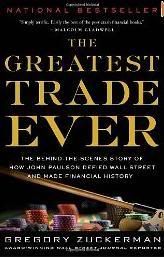
I finished this book in late August; it's about time I wrote the review.
"It's better to lose money conventionally than make money unconventionally." After reading Andrew Ross Sorkin's
Too Big to Fail and learning about what happened in the money-losing center of the maelstrom, I wanted to read about the crash's counter-current. This one fit the bill nicely.
John Paulson was among the few who saw the real-estate crash coming, but he was not the only one. Gregory Zuckerman tells the stories of several individuals who tried to "zig" while others were "zagging;" Paulson just happened to make the right decisions at the right time with enough financial backing to come out "more ahead" than anyone else.
Here's what he did right:
- He bought credit default swaps (CDSs) to hedge against a fall in collateralized debt obligations (CDOs). CDOs were those securitized bundles of home loans that almost nobody thought would lose value (but did); the CDSs were basically insurance on the CDOs. (In essence, it was like buying insurance on someone else's car.)
- Near the peak of the bubble, while the insurance was super-cheap (about 1% of the protected value), he went all in.
- He set up a fund specifically dedicated to buying CDSs, with a built-in requirement to keep the money in until the end of 2008. When the market crashed and people started to pull their money from other, similar funds, Paulson refused to liquidate his positions.
- He had mathematical models that worked. Most other funds continued to predict home values would go up based on data stretching back to the early 1980s. Paulson's staff took into account the new mortgage tools lenders were using. They knew things were unsustainable.
- He kept a low profile so his competitors wouldn't notice.
- He only slowly increased his postitions in CDSs; this kept him under the radar.
- He compounded his gains by buying CDSs on the banks that were most exposed to sub-prime mortgage losses.
- By building on his credentials as a long-term, old-school investor, he was able to secure enough cash that liquidity was not an issue.
- Perhaps most influential of all was his age -- at 50, he was old enough to remember the last bear market (the 1970s) while still young enough to understand all the new developments in the industry. His financial security and wisdom put him in the best position mentally to take full advantage of events.
While the market crashed, his funds made over $15 billion -- a several hundred percent rate of return.
I appreciated the fact that Paulson was an introvert -- unlike other fund managers of the time, he was thoughtful and long-term focused. I also liked the way he wasn't afraid to stand up to the statistical analysis of his peers. While true that the larger firms had their own teams, these groups were composed mostly of recent graduates who knew more about the math than the market.
I think this book better explaining the group-think of pre-crash Wall Street. It's a fascinating read for understanding the ins and outs of the financial sector's culture, and a great lesson(/warning) for those who would chart their own course in life.
 I finished this book in late August; it's about time I wrote the review.
"It's better to lose money conventionally than make money unconventionally." After reading Andrew Ross Sorkin's Too Big to Fail and learning about what happened in the money-losing center of the maelstrom, I wanted to read about the crash's counter-current. This one fit the bill nicely.
John Paulson was among the few who saw the real-estate crash coming, but he was not the only one. Gregory Zuckerman tells the stories of several individuals who tried to "zig" while others were "zagging;" Paulson just happened to make the right decisions at the right time with enough financial backing to come out "more ahead" than anyone else.
Here's what he did right:
I finished this book in late August; it's about time I wrote the review.
"It's better to lose money conventionally than make money unconventionally." After reading Andrew Ross Sorkin's Too Big to Fail and learning about what happened in the money-losing center of the maelstrom, I wanted to read about the crash's counter-current. This one fit the bill nicely.
John Paulson was among the few who saw the real-estate crash coming, but he was not the only one. Gregory Zuckerman tells the stories of several individuals who tried to "zig" while others were "zagging;" Paulson just happened to make the right decisions at the right time with enough financial backing to come out "more ahead" than anyone else.
Here's what he did right:
No comments:
Post a Comment